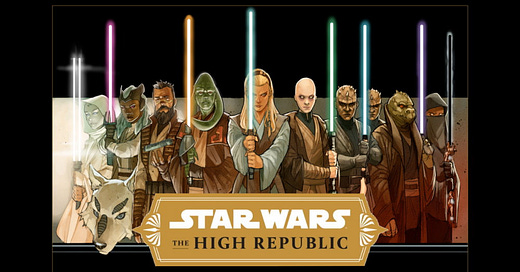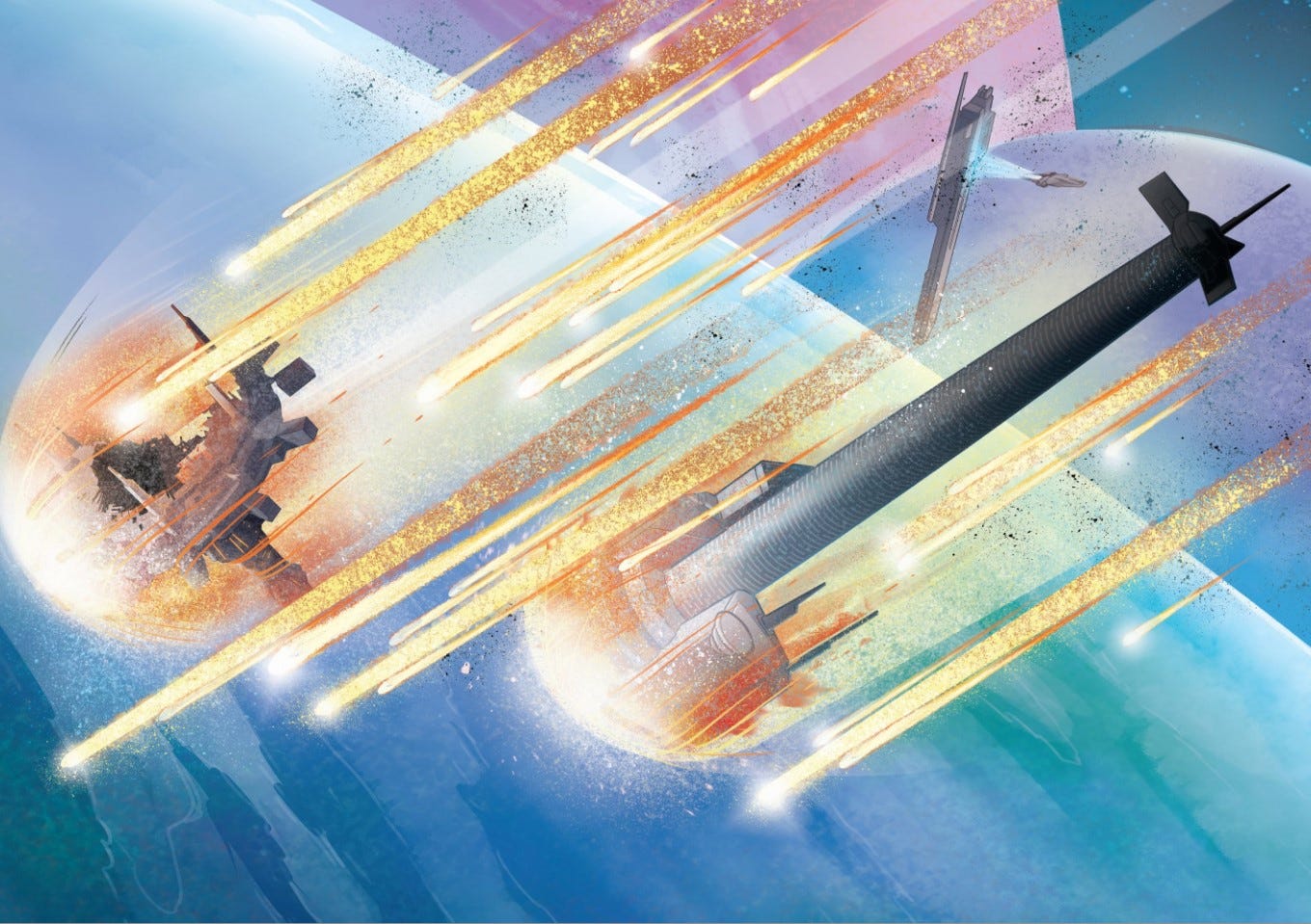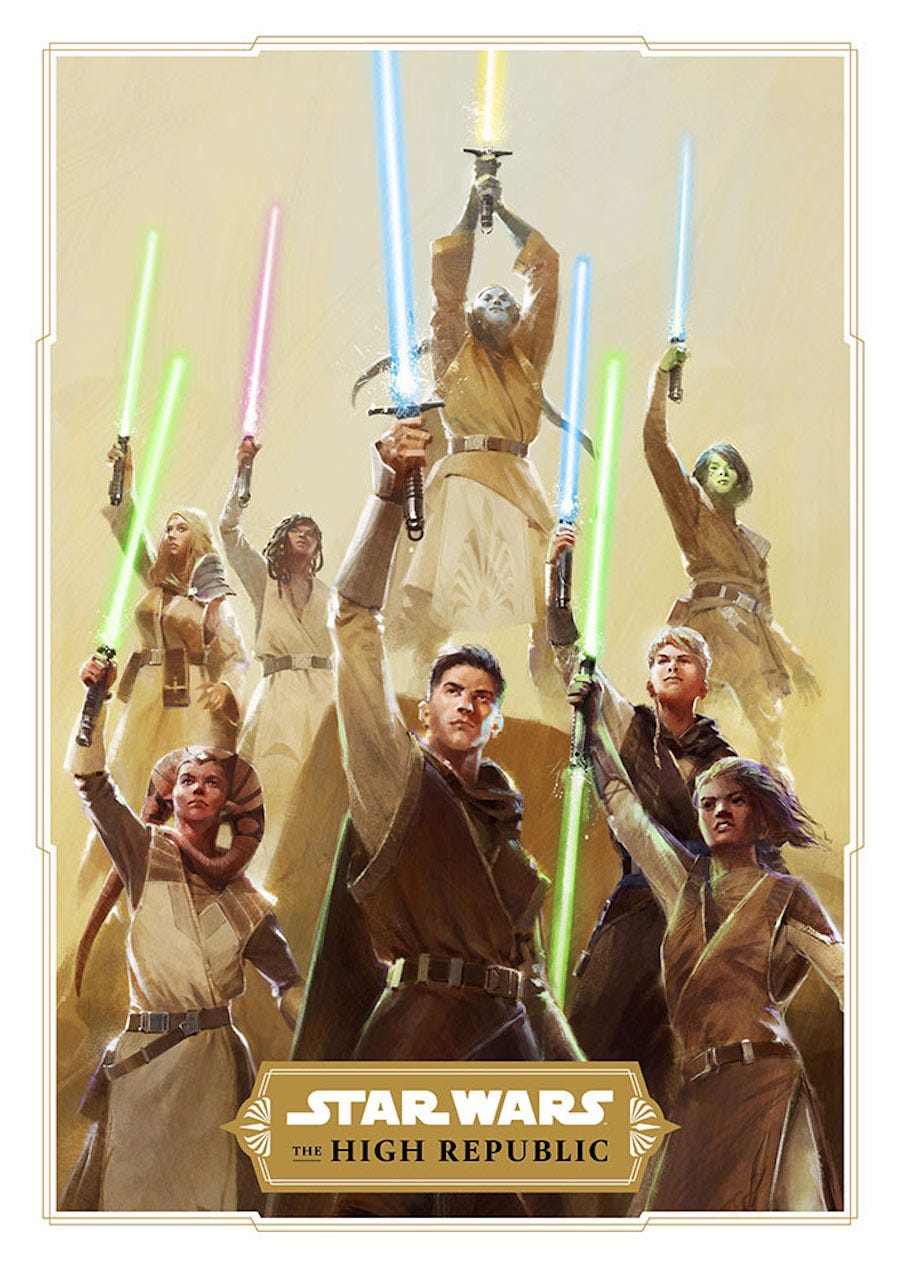Image credit: Fanthatracks
Next week, the celebrated Star Wars publishing program, dubbed The High Republic, accelerates its third and final phase, Trials of the Jedi, with the publication of the novel The Eye of Darkness by George Mann. The publishing program, which is the most ambitious in the history of Star Wars, has grown since 2021 to encompass adult, young adult, and middle grade novels, as well as comics books, manga, picture books, a children’s animated show, and, of course, a range of wearable, collectible, and playable merchandise. If you spend any time on the parts of the internet where Star Wars book fans congregate, you’ve undoubtedly seen the zeal, if not fanaticism, with which fans of these stories have embraced the characters, factions, and creatures of this era. Speaking as just one of the many devotees, I will say that these stories reinvigorated in me a love for Star Wars publishing that was at a low ebb in engagement prior to 2021.
Yet, in the same period as the High Republic, live action Star Wars films and television have been in a bit of a “wobble.”[1] The last film to be released in the franchise, 2019’s The Rise of Skywalker had fans and critics scratching their heads as much as (or perhaps more than) pumping their fists, and the many ongoing Disney+ television shows have yielded a wide range of quality, often finding success with either diehard fans (Ahsoka) or the critic class (Andor) but all seemingly falling far behind the cultural impact of the first season of The Mandalorian. Star Wars fans remain voracious in their consumption of these products, but the volume of announced and then rescinded projects (Patty Jenkins making Rogue Squadron, Rian Johnson developing a trilogy, Kevin Feige creating a film) has justifiably given fans reason to be uncertain about the projects out there.
Now, to put my sabacc cards on the table, I always think the “wobble” at Lucasfilm is overexaggerated and not all that different from the “Development hell” many Hollywood projects experience. While more recent offerings may not always please every generation of Star Wars fans, there is still reason to think the franchise is alive and well. But for those of us who love the franchise, it’s only natural to want to see it in a stronger position, captivating a wide swath of fans and garnering the respect of critics.
So, on the eve of a big new phase of High Republic texts, let’s examine the aspects of that project that have made it such a success and pull out some key lessons that the Lucasfilm dianoga should transfer from the publishing tentacle to the live action tentacle.
Image credit: Starwars.com
1.) TRUST YOUR CREATORS
The High Republic initiative was directly and deliberately cultivated in the rich soil of a small group of creative minds, who got to imagine, shape, and challenge Star Wars lore and mythology in a whole new era. In a now legendary retreat, Lucasfilm Publishing (under the leadership of Creative Director Michael Siglain) brought together authors Charles Soule, Justina Ireland, Cavan Scott, DJ Older, and Claudia Gray and (essentially) gave them a blank slate to let them design and develop Star Wars in an entirely untouched part of the canon. The group, over the course of the retreat, played out many strategies and ideas but eventually set upon the High Republic era. Together, over the last 4-5 years, they have designed and guided the projects from the ideas sketched at that retreat through countless New York Times Bestselling books and hit comic series. While it is impossible for any of us to know the exact working dynamics within the group, it seems like the parent company has largely let the creators take the lead and only redirected energies when they would impact other projects[2].
In contrast, it seems like every Star Wars live action project has suffered from the larger corporate machinations that too often leave the end results suffering from a feeling (if not a reality) of too many cooks in the kitchen. While this, at times, causes kerfuffles that reach the public eye (Gareth Edwards not overseeing the Rogue One reshoots, Phil Lord and Christopher Miller leaving Solo mid-filming), it seems to result in the quiet whimper of a project’s demise and the standard “creative differences” press releases more often. While every situation is different, the larger pattern revealed seems to be the ability of Star Wars to attract young buzzy writers and directors, only to have those projects change dramatically or disappear before they can reach fruition[3].
The comparison here is illustrative, and while I’m sure this is too simple a take, the lesson is to hire the strong creative figures, and give them as much freedom as you can. Now, the stakes may be much different with feature film and streaming budgets, but our current moment requires that all film and television have a clear vision and be shaped by a perspective that can help it to stand out in the crowded marketplace. While not every creator is ready for the demands of modern blockbuster filmmaking, they should be surrounded by executives and mentors that can help them elevate their craft to their vision, not reduce their vision to fit outside demands. As we have seen, Dave Filoni was mentored by George Lucas, and Kathleen Kennedy became great with the help of Steven Spielberg; it is time to give creatives space to become the great writers and directors of the next age of Star Wars. Only then will we get the panoply of voices and perspectives that can enliven the franchise.
Image credit: Wookiepedia
2.) DON’T BE AFRAID TO BE WEIRD
A common complaint about the sequel trilogy, despite its many creative and artistic leaps, is that it often felt like a rehash of the original trilogy. I would, as always, argue that this is not a perfectly fair criticism, but it is true that the primary directive after the Star Wars prequels seems to have been to return to the familiar environs (literal and figurative) of the original trilogy, and keep fans fed with nostalgic content. It makes sense. The Millennium Falcon toys will always sell, but part of the “wobble” moment may just be that we’ve had the same reheated content so many times that we just can’t stomach it again.
Here again, the High Republic took big swings: A sentient carnivorous plant species invading the galaxy and consuming all it finds; elite Jedi Torban Buck whose ferocity earned him the nickname “Buckets of Blood” but whose true passion is in baking; a rogue swashbuckler with all the swagger and game of a true lothario, who just happens to be a sentient rock. While mileage can vary for any particular fan on any single project or choice, what makes so many of these big swings homeruns is that they brought a new dynamic, threat, or tension into the familiar galaxy.
Every entry in the High Republic has some way to push outside the familiar and offers a challenge to what Star Wars mythology has been, but has equal measures of jedi, lightsabers, scoundrels, starships, and droids. As long as the familiar rules apply, fans are ready to get something weirder and fold it in to our understanding of the galaxy. Jabba the Hutt was a giant bold and weird addition when he first appeared in Return of the Jedi, but now the huts are one of the most iconic species in the galaxy. Continuing to push the boundaries can only make a bigger sandbox for others to play in.
Image credit: Laughing Place
3.) WELCOME EVERYONE TO THE GALAXY
Star Wars is and has always been for everyone, but that doesn’t mean Star Wars has always let everyone see themselves in the galaxy far far away. The High Republic has been exemplary in its inclusion across race, gender, and identity lines, making it clear that everyone should be able to see themselves represented. Flip to any of the character concept art found in the gorgeous Art of the High Republic, and you’ll see a diverse range of skin tones, gender identities, and hair styles (yes, this matters!) that has been profoundly missing in the live action part of Star Wars.
Beyond that, the creators have given us a range of non-binary, asexual, and gay characters that remind us that the galaxy is a big place with every type of being in it. And yet we are told that we need to have more patience with this kind of representation in live action. While Rise of Skywalker featured the first queer characters in the franchise, they were not main characters (quick name them!), and their loving kiss, presented as significant by the parent company, just so happened to be easy enough to snip out of foreign releases.
It’s not always fun to be a Star Wars fan on the internet. While I get thrills from seeing passionate cosplayers, thoughtful commentators, and enthusiastic trivia aficionados, just as often, we see the nasty sides of bullying, gatekeeping, and sexism/racism rear their ugly heads. Despite decades of an active and vibrant fandom, too many fans still work to exclude others and dictate who the “Real fans” are. It’s our duty to call out these awful members of the community and starve them of our clicks, follows, and likes (the only currencies they understand).
In my (limited) view, I think the executives at Lucasfilm understand this and generally want to create an exclusive space in which all fans are welcomed, but in trying to listen and be responsive to their fanbase, the company has made bad mistakes in thinking the loudest voices are the majority, or that negative reception to a character or idea from the Youtube laser-eyes crowd represents how all fan see it. The company has done a lot of good but needs to be bolder and push back harder against the anti-woke trolls to make sure that “Star Wars is for everyone” is a guiding philosophy and not just a cool t-shirt.
The High Republic authors, artists, and creators have shown that true diversity and inclusion is not only simple to achieve, but it makes for BETTER STORIES. Storytelling is at its best when it helps us see ourselves in others that are different than us. This is how we grow as readers and as people, and I am grateful for every character in the High Republic that has improved me as I shared their adventures, hopes, dreams, triumphs and tragedies.
Image credit: Wookieepedia
4.) HAVE REAL STAKES
Star Wars is unlike any other franchise in pop culture in the way that it has, from its beginning, moved back and forth a limited timeline and continually filled in gaps primarily across a range of about 60 years in that galaxy. This is a great part of the franchise, and fans (myself included) love to learn what happened between films, such as how the end of the Empire in Return of the Jedi turned into a New Republic in the time of the Mandalorian that allowed the First Order to rise as The Force Awakens approached. This has allowed for some truly unique storytelling that has enthralled fans for generations, but it also has put strong limits on stakes within that storytelling.
Too often, we read a novel or comic, or watch a show or movie without having any fear that characters are in real danger because we know the character’s fate in later parts of the timeline, or that one faction can’t really win in a conflict (say…Thrawn in the Disney+ shows) because we know who is in power in the next film. Sure, a story can still be engaging and fun, but the thrill is often reduced or stakes ring hollow.
This was the real genius of the design of the High Republic: jumping back 400 years left only a small set of characters (Yoda, Maz Kanata, Yareal Poof) in play, and meant that all the stories have real danger and a true unknown quality. We may know in the widest possible scope that the Republic can’t fall until the Prequel Trilogy, but everything else is in play, and the creators are ruthless in making sure those stakes remain all too real. Within the High Republic, characters regularly die, creations rise and fall, and even the highest heroes can fall. While earning a heartless reputation, these creators remind us that the real value of storytelling is in the thrill of triumph and tragedy, and there is no better pain that that of mourning a character or creation in whom we have invested our time and emotion.
Image credit: Yahoo
5.) HOPE SURVIVES
Yet, no matter how dark and upsetting the works of the High Republic can be at times, no matter how monstrous or tragic events can feel, there is always one abiding feeling that reigns supreme: hope.
We live in dark times, with serious and complex issues threatening us and making us feel fear and anxiety in ways that, when properly examined, overwhelm us. We are driven to films, television, books, and comics to find respite from these emotions and to escape, however briefly, into an imagined world of heroes and sorcerers, scoundrels, and just a bit of whiz-bang pew pew magic. That escape matters, and it is important, offering us a cathartic release that fuels us for the real battles ahead.
Whenever I escape into the High Republic, I feel that release. I feel that comfort found only in the simple hopeful notion that when good people act to do what is right, there is no setback that is permanent, no loss that we can’t survive, and no tragedy that can’t be overcome. The High Republic reminds me of why I go to stories: to find comfort, to find inspiration, and to find hope that I to can be heroic in ways small and grand.
Fans are flocking to High Republic to feel this hope. We laugh together, we cry together, and we remember what makes Star Wars great. George Lucas’s original definition for the force was absurdly simple: the dark side is selfish, and the light side is selfless. To be selfless is to choose to believe in something great than ourselves and to give of ourselves to preserve that. The High Republic has been a gift for all these reasons and the franchise can continue to benefit from these gifts as it moves forward, and onward, for light and life!
[1] I am stealing this label from Joanna Robinson, podcaster and coauthor of MCU: The Reign of Marvel Studies, who uses it to describe the struggles the other once gilded lily of the Disney garden is currently experiencing.
[2] Famously, the group, among many other ideas, considered stories of a very young Yoda, but were told that it would be best to not head in that direction, given the encroaching Baby Yoda phenomenon that was, at that time, still secret to only the upper levels of the company.
[3] I’ve stayed broad here and insist that anyone on the internet telling you the ‘real story’ behind all these situations would be wise to do the same. There are a lot of bad actors casting villains, but those in the room where these things happen stay diplomatic and generous.









